Demo showdown: Metal Gear Rising: Revengeance
Digital Foundry puts the Xbox 360 and PS3 samplers to the sword.
Cancelled by Konami and then resurrected via the coding talents of Platinum Games, Metal Gear Rising: Revengeance is a title sure to court controversy. For a multi-million-selling franchise built around stealth, Platinum's redux pays only a passing regard to the series' heritage, instead focusing on what the team does best: phenomenal, borderline-insane, action. A playable demo - out today - allows you to judge whether Hideo Kojima made the right choice with this new approach to the title.
Little was seen of the original version of the game before its mysterious cancellation, but based on the E3 2010 presentation we watched at the Microsoft conference, two aspects jumped out to us. Firstly, there was the fact that the game was operating at a locked 60 frames per second on what seemed to be a PC - a little surprising bearing in mind that Metal Gear Solid 4 jumped sporadically between 20 and 30FPS at any given point (Kojima himself later confirmed that the old version of the game was indeed 30FPS).
The second element was the inclusion of a "Zan-Datsu" blade mode - which gifts the player the ability to cut virtually any object in the game into pieces. Lots of pieces. At the time, our thought was that the game engine may struggle with the sheer amount of dynamically generated geometry if this feature wasn't properly managed.
The demo code we played on both Xbox 360 and PlayStation 3 shows that both of these elements have been expertly handled to the best extent we might have hoped for. Platinum Games has prior experience in targeting 60FPS, having done pretty well at sustaining it in its Xbox 360 rendition of Bayonetta, and that work pays off here: the team has retained high-poly characters with beautiful designs, with the only obvious drawbacks coming from a slightly flat-looking lighting scheme and some minor LOD-popping issues. Environmental detail is relatively high and some lovely effects work offsets the muted lighting.
"From a gameplay perspective, the demos suggest that the core experience is just as good on both Xbox 360 and PlayStation 3."
The implementation of Zan-Datsu is good too: there are clear limitations on what may be cut and to what extent, but the execution is so focused on specific gameplay objectives that the trade-offs are not so apparent: why carry on slashing an opponent into tiny, insignificant, little pieces when you can grab his cybernetic energy unit and recharge yourself? Do we really begrudge the fact that inconsequential scenery can only be sliced a few times before flickering into nothingness?
While we believe the demo we played to be of a certain age - and perhaps not entirely representative of final code - it does give us some flavour of the quality of the conversion work. Fans of Platinum Games may recall that the developer retook control of its PS3 destiny, after witnessing a shockingly poor conversion of its Xbox 360 classic Bayonetta, with the stunning Vanquish, which had its charms on both platforms but on balance was probably just a touch more refined on PlayStation 3.
Certainly, there are parallels from a tech perspective with the still-brilliant robo-shooter. Principally it comes down to the implementation of v-sync: the long and the short of it is that the PlayStation 3 game has it and the Xbox 360 version doesn't. Metal Gear Rising on the Microsoft console tears whenever the engine slips from its 60FPS target, and as you can see from the performance analysis further down the page, that occurs frequently. Over the years we'd like to think that we've developed quite a lot of sensitivity to this effect, but this is definitely a situation where the cold, hard, mathematical precision of the analysis is not reflected by human perception - only in screen-filling, effects-heavy scenarios is it obvious and even then it manifests more as a kind of vertically descending "wobble". We'd also put fairly good odds on the Xbox 360 game commanding a small frame-rate advantage in like-for-like scenarios, based on what we learned about Platinum's tech from Vanquish - though this is something we lack much in the way of source material for in the demo.


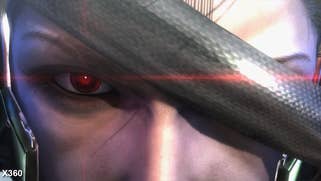

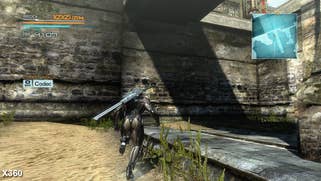
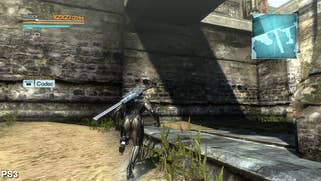
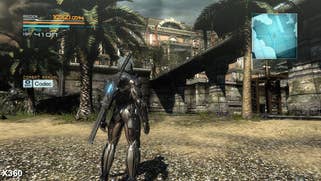
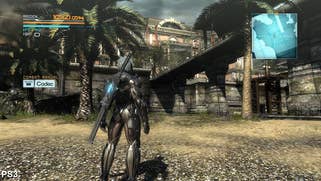
Other changes are minimal - slight adjustments to the LODs, which do visually pop, particular as you move closer to environmental landmarks and especially when it comes to shadows. These are dithered via a four-sample offset on Xbox 360, while on PS3 there's hardware PCF (percentage closer filtering) that gives them a somewhat harder edge. There appears to be some minor variation in some minor graphical effects, but nothing that adds or takes away from the overall presentation.
In truth, the biggest point of difference between the two versions comes down to the quality of the cinematics. The PS3 demo sails north of 3GB, while the Xbox 360 game is just 1.8GB.The variance here appears to be almost entirely down to the video sequences - they're of a reasonable enough quality on the Microsoft console, but it's no exaggeration to say that they're almost entirely pristine on the PS3 - that's all down to the presence of the Blu-ray disc for the final build, which offers Platinum so much more raw storage, allowing for higher quality video encodes. In terms of the demo though, that increase in quality means you'll be hanging about a lot longer for it to finish downloading before you can play.
But regardless of platform, the wait is worthwhile. There should be enough Metal Gear DNA in here to satisfy the purists in terms of storytelling and design, but few can argue with the sheer quality of the gameplay - while Rising looks and feels like a state-of-the-art console video game, the 60Hz feedback sets it apart. Combined with the uniquely Japanese approach to the audio-visual mix, the Metal Gear Rising: Revengeance demo is unmissable - the perfect starter before the main course arrives on February 22nd.
This piece was produced ahead of the release of the demo on PSN and Xbox Live, using the versions bundled with the Zone of the Enders HD Collection. At the time of writing we can confirm that the Xbox 360 download is a match for the previously released code.


















